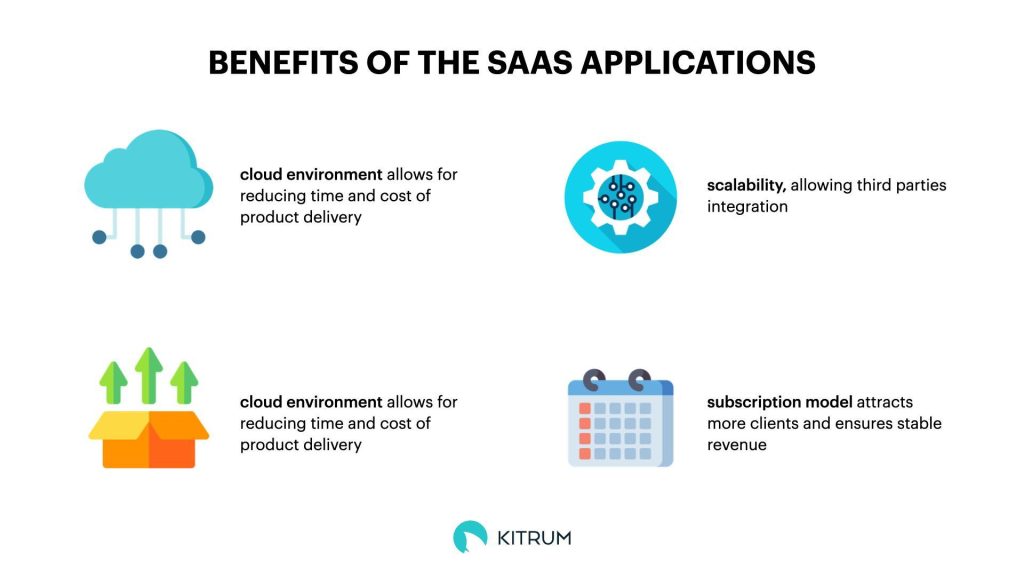While Software As Service is not a new concept, it remains to be the next big thing. For the last couple of years companies have explored the opportunities, released SaaS customers seemed to approve, and today you can hardly find any person who doesn’t use one of them.
Google G Suite, Zoom, Shopify, Salesforce, Slack, Dropbox, Netflix, or Spotify – these are just some of those SaaS platforms you might be using yourself.
Many enterprises have adopted SaaS to speed up their internal processes by integrating technology into the system. Today companies with less than 50 employees use 16 SaaS applications. While those who have 50-100 employees use around 24 of them, companies with up to 500 people on the team use twice more SaaS apps. Companies with more than 1000 employees utilize 177 SaaS applications.
2022 is believed to be the most profitable for the SaaS industry; its annual growth is supposed to reach $171.9 billion by the end of the year. The revenue growth of separate companies confirms this provision. For example, in June, Netflix’s year-over-year revenue was $31.031B, with a 12.49% increase. Salesforce revenue was $29.320B, a 24.56% increase, and Shopify revenue were $5.002B, a 29.82% increase year-over-year.
It makes the SaaS market one of the fastest growing and attractive for those who provide cloud computing solutions to consumers. You can connect a SaaS solution to your existing app or computer system to function together and automatically exchange data.
Are you interested in discovering possibilities for your business to build a SaaS product? First, let’s figure out what it takes to develop one.
What is SaaS and its benefits?
SaaS is a business model in which you can access services over the internet. They are hosted in the cloud. Thus there is no need to install them on your computer.
Businesses can use SaaS applications for various cases. Those apps include project management tools, business intelligence software, business operations management, collaboration, and marketing tools.
Private users may also use them to receive streaming content, creative purposes, E-learning, data storage, and communication.
The SaaS model is an alternative to software licensing when a developer sells the license. It typically works by monthly or yearly subscription. It makes your application accessible even to small businesses and single users with low budgets. It is beneficial in reaching a wider audience and gives stable revenue. Regular income will allow you to plan developments to provide your audience with the best tools and make more subscriptions.
SaaS has multiple benefits for users and developers. First of all, it is easy to deploy. The cloud environment allows for reducing the time and cost of product delivery. All updates are made within the cloud. Thus maintenance is easier. The users also don’t have to wait for years for the new version of the product. SaaS apps usually update automatically, so the users don’t have to worry about it.
The cloud environment is usually scalable and allows integration with third parties. Using the APIs, you can include third-party features into your app to cover the needs of your users that may evolve with time. You can also provide different subscriptions, where the user can choose what services he needs and choose a plan according to them.
SaaS apps don’t need hardware with specific requirements to use your SaaS application. It can run on any kind of device with Internet access. SaaS is also attractive for users, as they can run the app on different devices with one access to work with the same data every time.
Furthermore, a cloud provides reliability, as it is a network of servers that may be located in different parts of the world. Even if one goes down, the app will still be running.
SaaS application development steps
Of course, everything starts with the idea of your future SaaS app: what services you want to build and who should use them. Remember that your audience should repeatedly need your services, as this is the core idea of any SaaS app.
After you get an idea, it should be validated. Before the actual development, you should conduct market research, discover your competitors and learn the target audience. Define the aim of your app and how it will be better than those already present. Think of the main features your app will perform and move to the next stage. You can use the help of a Business Analyst, which may be a part of your service provider’s team. The specialist will help analyze and develop the best solution to develop your idea into an actual product.
Discovery phase
The Discovery phase will help you estimate the time and budget needed for development and create documentation that will be guidelines for your development team. During this phase, you will set the features of your future app and asses risks. Here’s how a product discovery tool can help you in this phase: it is a software or platform that helps companies and product teams identify, prioritize and validate new product ideas or features. It will make your product development decisions data-driven and successful.
In the end, you will have a Software requirements specification document with a feature description, technical specifications, the scope of work, and other requirements. During the discovery phase, you will define the team composition and structure to build your SaaS app.
The cases may be wary, but usually, the team consists of the following specialists:
- Project Manager
- Business Analyst
- UX/UI Designer
- Backend Developer
- Frontend or Mobile Developer
- QA tester
Sometimes, if the product needs to be tested, your discovery team can advise you to build a Minimal Viable Product. A limited audience will use it and give you feedback. You can also monitor how the functionality works and what features might lack.
Design phase
App design consists of two notions: user interface and user experience. UI corresponds to what the user sees while utilizing the app, while UX is about navigating the platform and how he interacts with it.
Some components of the app have general rules for their appearance. For example, login space always looks the same in any product, or clicking on the logo on the website will redirect you to the main page from any place. But there are multiple aspects that you need to work on and figure out which kind of interface will be the most appealing for your audience. Beware that SaaS applications are approached through mobile and desktop, so your design should apply to both.
Also, remember that behind any designed button, a function should be executed with connections, integrations, and logic. So it’s more like the functionality of your app should dictate the design and not vice versa.
Development phase
The first thing to choose is an architecture that meets the technical requirements. SaaS architecture’s databases, storage, and services are in the cloud. There are various solutions to build cloud-based architecture, such as Amazon Web Services, Google Cloud, Azure, and more.
After choosing the architecture, developers build frontend and backend, while quality assurance engineers perform tests to ensure that functionalities work correctly.
After features were developed and the application tested, developers merged the entire code into the production. Usually, a DevOps engineer is in charge of the launch process. The product is being deployed and becomes available to the users.
For streamlined development, consider leveraging professional SaaS development services that can handle the intricacies of cloud-based architectures and deployment.
Still, this is not the end. The product needs further maintenance, which may include bug fixing, fixing issues after receiving users’ feedback, adding features that were not crucial during the first release but would benefit your product, and upgrading existing features. Be sure to preserve funds for maintenance, as this is part of the product lifecycle. The budget for it should be around 25% of development expenses.
Plan to Scale
You should think about scaling your product. If your SaaS application is not up to date and doesn’t answer your customers’ requirements, it may be one reason your project may fail. For this, you should follow the industry in which you are working and see what else you can offer to your users to make your product even more valuable for them. The subscription model is suitable for gaining more and more people and having a stable income, but for your users to continue the subscription, you should be better than the competitors. This requires constant maintenance and updates.


